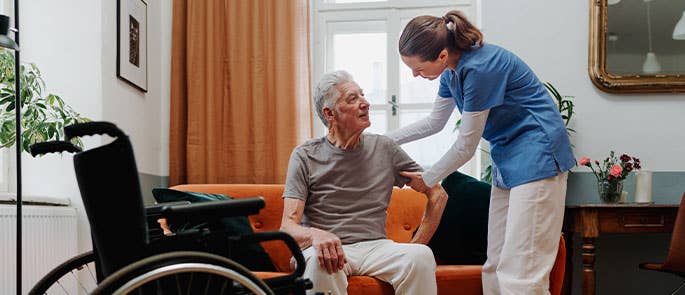Work-Related Musculoskeletal Disorders
Musculoskeletal disorders are often cited as one of the UK’s most common occupational injuries – HSE statistics tell us there are currently 473,000 workers suffering from work-related musculoskeletal disorders, resulting in 6.6 million lost working days. However, musculoskeletal disorders can easily be prevented if you follow safe manual handling practices – poor manual handling is the main cause of such injuries and so must be carried out correctly. In this article, we’ll look at what musculoskeletal disorders are, the symptoms of them and how you can prevent musculoskeletal disorders from developing.
What are Musculoskeletal Disorders?
Work-related musculoskeletal disorders (MSDs) are injuries to the muscles, tendons and nerves, often as a result of sprains and strains caused by overuse during work activities. They are commonly classed as upper-limb disorders (shoulders, wrists, forearms, hands and neck) or lower-limb disorders (legs, knees, ankles, hips and feet) but can also affect the lower back.
Specific named MSDs are carpal tunnel syndrome, tendonitis, tension neck syndrome, trigger finger, tennis elbow, radial tunnel syndrome, repetitive strain and slipped discs. All of these can be very painful and long-lasting and may prevent a person from carrying out work tasks.

Why are Musculoskeletal Disorders a Problem in the Workplace?
Musculoskeletal disorders are a problem in the workplace because they can stop you from carrying out work tasks, whether temporarily or more permanently. If you have an MSD caused by a work activity, then continuing to pursue that task will only make the injury worse and may cause long-lasting damage.
Those with musculoskeletal disorders can also go on to develop further health problems, including mental health issues such as depression. This is particularly true if the injury affects your wellbeing and the pain prevents you from carrying out normal tasks or doing activities that you enjoy.
Furthermore, the HSE tells us that, in 2022/23, 6.6 million working days were lost due to work-related musculoskeletal disorders. This creates a big problem for employers, who are losing large amounts of time and money as a result of preventable injuries. Companies may even lose employees due to ill-health, as MSDs can prevent them from performing their role at all.
Symptoms of Musculoskeletal Disorders
Symptoms of musculoskeletal disorders vary in severity from person to person and depend on the particular part of the body that’s been affected. General symptoms of musculoskeletal disorders include:
- Localised or widespread pain.
- Tingling muscles.
- Dull aches or numbness.
- Swelling.
- Twitching or ‘burning’ muscles.
- Aching or stiffness of the whole body.
- The sensation of pulled or overworked muscles.
- Limited movement.
- Fatigue.
- Disturbed sleep.
Causes of Musculoskeletal Disorders at Work
Musculoskeletal disorders at work are commonly caused by poor manual handling practices, including lifting, carrying, pushing or pulling an object, person or animal. Manual handling is not inherently dangerous but can cause problems if the tasks are done repetitively or forcefully, and without allowing enough time in between for rest and recovery.

Manual handling tasks that are particularly hazardous include:
- Moving heavy, bulky or awkwardly-shaped loads.
- Stretching to reach things, such as a high shelf.
- Twisting, turning or bending the back and neck.
- Stooping awkwardly to reach something.
- Gripping or clenching the hands tightly for a long time.
- Moving objects in a small space without much room to manoeuvre.
- Pushing/pulling with sustained or excessive force/
- Repetitive or prolonged work using the same movement.
- Moving something that’s beyond your personal capability.
- Working in constrained body positions.
Alongside manual handling tasks, musculoskeletal disorders can also be exacerbated by:
- Using hand-held power tools for a prolonged time (vibration).
- Working with display screen equipment (DSE).
- Long-distance driving or driving heavy vehicles.
- Extreme heat or cold.
- Work pressure, stress, demands of the job or lack of breaks.
- Working when physically tired.
Looking to Learn More?
If you’re at risk from musculoskeletal disorders because of your work, then our Manual Handling Training and Display Screen Equipment Training courses will help you recognise the hazards and understand what to do to prevent them from causing you harm whilst in the workplace.
Preventing Musculoskeletal Disorders in the Workplace
Musculoskeletal disorders are largely preventable if work tasks are carried out correctly and safely, and the appropriate control measures are followed at all times.
Poor manual handling practices are a common cause of musculoskeletal disorders in employees, whether you’re lifting, carrying, pushing or pulling something or someone in a care home, warehouse, construction site or agricultural setting.

If your job requires manual handling, then you can prevent the risk of MSDs by:
- Using an automated or mechanised method – instead of manually moving an item, can you use equipment or machinery to bear the weight for you? For example, trolleys, hoists and carts.
- Considering TILE – before carrying out any manual handling task, always assess it first to ensure you have all the information you need to perform the job safely. This means considering TILE – the Task, Individual, Load and Environment.
- Breaking the load down – if possible, break the load down into several, smaller components so the weight you’re moving is lessened and more evenly distributed.
- Breaking the task down – if your manual handling task is prolonged or repetitive, remember to take breaks every so often to rest your muscles, stretch and loosen up ready to carry on.
- Knowing your limits – do you know how much you can safely lift before a load becomes too heavy? Familiarise yourself with safe weight limits and never carry out a task if it’s beyond your personal capability.
- Checking your footwear – your shoes may be the last thing on your mind, but slips, trips and falls when manual handling can easily be caused by wearing incorrect footwear. Ensure your shoes have good grips on the soles, covered toes and supportive ankles to prevent injuries.
- Changing the layout of the workplace – can you reduce carrying distances, eliminate the need for lifting things to high up shelves or avoid twisted body postures by repositioning things in the work area?
- Adjusting the conditions of the workplace – improving lighting, flooring and temperature can also reduce stress and make manual handling tasks both easier and safer. Ideally, you want as much natural light as possible, a non-slip floor and a temperature that isn’t too hot or cold.
- Asking another person to help – team manual handling is often safer than carrying out manual handling on your own, as the load is shared and the weight is distributed between several people. Just remember to communicate well between team members.
- Ensuring you know how to lift, push and pull safely – undertaking training in manual handling practices is important, as it makes sure you know how to carry out tasks correctly and safely in order to avoid injury.
Musculoskeletal disorders are a common workplace injury, especially when your job role involves manual handling tasks. However, MSDs can be prevented if you carry out tasks with care and remember to take regular rest breaks, as this will prevent your body from becoming overworked and stop musculoskeletal disorders developing,
Further Resources:
- Health and Safety Training For Employees
- A Guide to the Most Common Workplace Hazards
- Managing Occupational Health in Construction
- What are the Consequences of Poor Manual Handling?
- DSE & Posture Checklist for Standing Desk Users
- Team Manual Handling Tips
- The 5 Most Common Occupational Illnesses (and How to Prevent Them)











